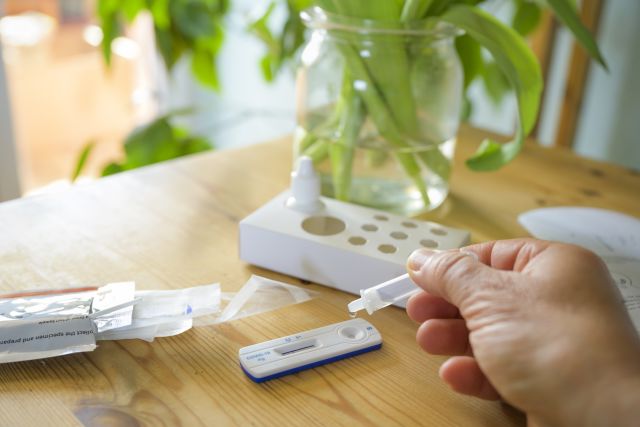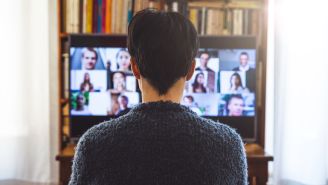Updated on January 17, 2022.
New COVID cases and hospitalizations in the United States have hit record highs. For most people, health officials say the question is not if they will be exposed to the highly contagious Omicron variant, it’s when.
Amid the Omicron wave, people need—and want—to know if they’re infected or if they’re free to safely go to work, attend school, gather with others or travel. At-home COVID tests can help provide that clarity.
Self-tests have emerged as a vital tool for slowing the spread of the disease and easing the burden on overwhelmed hospitals across the country—if you can get your hands on one. Demand for these rapid antigen tests have quickly outstripped supply, prompting people to hoard them or fall prey to fake testing kits that are not authorized by the U.S. Food and Drug Administration (FDA) and come with a high risk for inaccurate results.
The dire need and skyrocketing demand for rapid at-home COVID tests, prompted the Biden administration to purchase one billion FDA-authorized kits, which will be freely given to Americans. On January 14, the President announced that a half-billion tests will be available in a matter of days.
Each U.S. household is eligible to receive four free tests, which can be ordered online at COVIDTests.gov, starting January 18. There will be a call line for those without internet access. The tests will ship via the U.S. Postal Service within seven to 12 days, according to Biden’s plan.
People can also choose to pick up their tests at a local store or pharmacy. Those who do can still receive their kits at no cost, or they may be reimbursed. Anyone charged for a test should submit their receipt to their insurance company, which is required to reimburse up to $12 per test.
Under Biden’s initiative, health plans must cover a total of eight at-home rapid COVID tests per person enrolled in the plan each month. For example, a family of four would be eligible to receive up to 32 self-tests per month free of charge. (This rule pertains to over-the counter tests. There is no coverage limit to the number of tests that may be ordered by a healthcare provider.)
Are at-home tests accurate?
COVID self-tests can be taken at home or anywhere. And they can be used regardless of whether you are vaccinated or have symptoms.
At-home rapid COVID tests are antigen tests—not PCR (polymerase chain reaction) tests. Both antigen and PCR tests check for the coronavirus using saliva or a respiratory sample.
But PCR tests look for evidence of genetic material from the virus. Antigen tests, on the other hand, are designed to detect fragments of proteins found on or inside the virus.
PCR tests are typically more accurate than antigen tests but take longer—hours or days—to process. Antigen tests can provide results within minutes, and a positive test result is very reliable. The downside: Rapid antigen tests tend to miss more positive cases than PCR tests. So, a negative antigen test result may need to be confirmed with a follow up antigen test or a PCR test.
For this reason, some at-home tests kits are designed to be performed over the course of a couple days. Multiple tests can help reduce the risk for a false negative result—if you’re using a test that’s authorized by the FDA.
Unauthorized fraudulent COVID test kits are being sold online, the FDA cautions. It’s important to verify that the test you use is among those authorized by the agency. These manufacturers and brand names have been approved by the FDA. If your test isn't on that list, do not use it or rely on its results. Also make sure to check the expiration date on any at-home test.
When to use an at-home test
It’s a good idea to self-test if you have COVID symptoms or you’ve been exposed to someone who is infected. You should also test if you suspect that you’ve been exposed.
But even if you don’t have symptoms and have not been exposed to COVID, performing a self-test after traveling, before going to an indoor event or gathering with people can help inform your decisions. It can help reduce your risk of unknowingly spreading the disease to others, particularly children younger than 5-years old who are too young to be vaccinated as well as older people and those who are immunocompromised or at higher risk for severe disease.
How to use rapid self-tests
Even before you open the test kit box, clean the countertop, table, or other surface where you will do the test. Have a timer on hand in case you need to time specific steps during the test. Lastly, before you begin, wash your hands with soap and water for at least 20 seconds.
Next, open the box and pull out the instructions. At-home COVID test kits come with detailed directions and illustrations on how to perform the test correctly. Most self-tests require you to collect a nasal specimen but some use saliva. Read through the instructions carefully before opening any testing instruments or attempting to conduct the test. And perform the test only after you’ve read through and understand the steps involved.
Some test manufacturers may provide additional resources, such instructional videos, to help you take the test correctly. The Centers for Disease Control and Prevention (CDC) reports also offers instructions and tutorial videos on self-testing.
If you don’t perform the test as directed, you may receive inaccurate results. This includes reading your results within the timeframe indicated—not before or after.
Once you’ve completed the test and have your result, carefully discard the used swabs, tubes, and test. Do not reuse anything. Clean the surfaces where the test was performed and wash your hands. If you have unused tests in your kit, store these remaining components according to the manufacturer’s instructions
You got your result—now what?
If you test positive, you are very likely infected with COVID and should take the following steps:
- Isolate yourself at home. If you live with others, stay in a separate room, and use a separate bathroom, if possible. Avoid sharing household objects and wear a well-fitting mask around others.
- Let your healthcare provider (HCP) know you’ve tested positive and seek medical attention if your symptoms become severe.
- Inform all people who had close contact with you in the days leading up to your positive result.
- Stay at home for the next 5 days.
- After 5 days, if you are fever-free without medication for 24 hours and you have no symptoms or your symptoms are resolving, you can leave your home. But you should wear a well-fitting mask around other people for another 5 days.
If you test negative, you may not be infected and may be a low risk of spreading COVID. But one negative antigen test doesn’t rule out infection.
A negative result means the test didn’t detect the virus. It’s still possible that you are infected, however, if the test was performed too early in your infection. If so, you may test positive a day or two later. Repeating the test at least 24 hours later can give you more confidence in your result.
This doesn’t mean vaccines are ineffective or unnecessary
Fewer people may escape Omicron’s crosshairs but vaccinated and boosted people can expect to fare much better than those who aren’t, according to Anthony Fauci, MD, President Biden’s chief medical advisor. "Omicron, with its extraordinary, unprecedented degree of efficiency of transmissibility, will ultimately find just about everybody," said Dr. Fauci during a January 11 interview with J. Stephen Morrison, senior vice president of the Center for Strategic and International Studies.
"Those who have been vaccinated ... and boosted would get exposed. Some, maybe a lot of them, will get infected but will very likely, with some exceptions, do reasonably well in the sense of not having hospitalization and death." On the other hand, unvaccinated people are "going to get the brunt of the severe aspect of this," Fauci warned.
As of early December, unvaccinated people are nine times more likely to be hospitalized than children and adults ages 12 and older who are fully vaccinated, the CDC reports.






